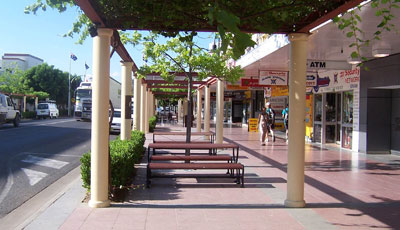|
Moree is a town of 8,000 in northern New South Wales. Located on the banks of the Mehi River in the centre of the rich black-soil plains, it is a major agricultural centre, noted for its part in the Australian cotton growing industry which was established there in the early 1960s.

Where is it?: New South Wales: Central & Far West. Moree is 573 km north west of Sydney on the Liverpool Plains. It strategically placed at the junction of the Gwydir Highway and Newell Highway, the latter of which is the major inland road between Melbourne and Brisbane. Moree has a daily XPT train service from Sydney via the Hunter Valley.
Things to see and do:
Moree Plains Gallery is one of the most historical buildings in Moree. It houses major touring exhibitions & local art and is also home to many different cultural events and functions such as piano recitals, choral performances, classes and workshops. In the gallery are permanent displays of aboriginal material including Kamilaroi items and bark paintings from Arnhem Land.
Moree is famous for its Hot Mineral Baths which originated in 1895. The baths were discovered accidentally when searching for irrigation water. These mercurial waters are from bores sunk into a huge Artesian Basin. 300,000 visitors of all ages visit annually. Many believe in the healing powers of the Artesian mineral waters. There are two large hot pools with temperatures ranging from 39 to 41 degrees.
The town is the fishing outdoors camping mecca of the Gwydir Delta with three major waterways within 25 minutes of Moree. You can throw in a line at one of the areas three weirs: Tareelaroi, Boolooroo and Combadello.
Surrounding area:
The Trawalla Pecan Nut Farm is the largest orchard in the Southern Hemisphere. Boasting 70,000 trees, Trawalla Pecan Nut Farm produces 95% of Australia’s Pecan crop. The farm is located about 35 kilometres east of Moree on the Gwydir Highway. Visits to the pecan nut farm can be made by tour only.
About Moree
Moree Plains features sub-artesian waters which reach natural temperatures of up to 41 degrees Celsius. The benefits of the Natural Artesian Mineral Waters were discovered years ago and have been used for their curative powers since ancient times. Water from the springs are used in artesian baths which bring people from all over the world to Moree. The Moree Hot Mineral Baths complex has been established to cater to those seeking its therapeutic value.
Moree is the centre of the largest single cotton producing area in Australia, where two thirds of the nation's cotton is grown. The cotton is planted in September/October and is the harvest begins late March.
History: The Kamilaroi people, whose descendants are still in the town, were the early inhabitants of the area. Major Sir Thomas Mitchell went to the district at the request of the acting governor after the recapture of escaped convict George Clarke who told of a great river called the Kindur in 1832. Clarke had been living in the area to the south with the Kamilaroi from 1826-1831. Squatters soon followed in Mitchell's wake establishing pastoral runs, among which was 'Moree' (1844), from a Kamilaroi term believed to mean either 'long waterhole' or 'rising sun'.
In 1851 James and Mary Brand arrived and built a general store on the banks of the river in 1852. A post office was added the following year. The family sold up and moved to the Hunter Valley in 1857 but James died in 1858 leaving Mary with six children so she returned opened another business and in 1861 she opened the town's first inn.
Moree was gazetted as a town in 1862 with land sales proceeding that year. A court of petty sessions was established in 1863 and was followed by a severe flood in 1864. The first constable arrived and a police station was set up in 1865. The first church (Wesleyan) was built in 1867 when the town had a population of 43.
As closer settlement proceeded agriculture emerged as a thriving industry on the fertile flood plains. Banking began in 1876 and the first local newspaper was set up in 1881, at which time the population was 295.
The town became a municipality in 1890. During 1894 construction of the heritage listed Federation-style Lands office commenced and ended that years with the completion of the ground floor. The second storey was added in 1903. In 1895 the Great Artesian Basin which sits under Moree was tapped and yields over thirteen million litres of water every day. The bore was sunk to 3,000 ft. (900 m) deep in order to provide water for agricultural pursuits but was proved unsuitable for this purpose. The railway line and service from Sydney arrived in 1897.
Wheat cultivation increased after World War II with a flour mill built at Moree in 1951 and the first commercial pecan nut farm was established on the Gwydir Highway east of Moree in 1966. The Trawalla Pecan Nut Farm is the largest pecan nut farm in the southern hemisphere, growing about 75,000 trees. In 1994 the Gwydir Olive Grove Company was established when two Moree families started producing olive oil from olives grown in the area.
Moree was one of the destinations of the famous 1965 Freedom Bus ride, an historic trip through northern NSW led by the late Charles Perkins to bring media attention to discrimination against Indigenous Australians. It brought racial segregation in rural Australia to the attention of urban Australians, in particular at the Moree public swimming pool as well as pubs and theatres, where Aborigines were refused entry. At the Moree swimming pool, after a confrontation with the council and pool management, it was agreed that Indigenous children could swim in the pool outside school hours. However, this was immediately reversed when the bus left Moree.
|